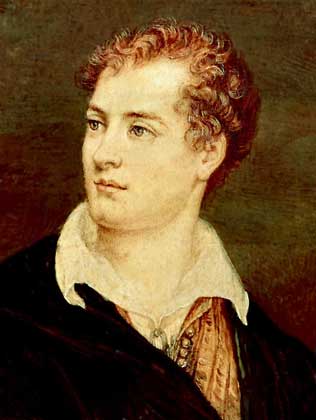The directory «Plots»
Byron George Gordon Noel Byron, 6th Baron
(1788–1824)

English poet and satirist.
He was the son of Capt. John (“Mad Jack”) Byron and his second wife, Catherine Gordon of Gight. His father died in 1791, and Byron, born with a clubfoot, was subjected alternately to the excessive tenderness and violent temper of his mother. In 1798, after years of poverty, Byron succeeded to the title and took up residence at the family seat, Newstead Abbey. He subsequently attended Dulwich school and Harrow (1801–5) and then matriculated at Trinity College, Cambridge. Although the academic atmosphere did nothing to lessen Byron’s sensitivity about his lameness, he made several close friends while at school.
His first volume, Fugitive Pieces (1806), was suppressed; revised and expanded, it appeared in 1807 as Poems on Various Occasions. This was followed by Hours of Idleness (1807), which provoked such severe criticism from the Edinburgh Review that Byron replied with English Bards and Scotch Reviewers (1809), a satire in heroic couplets reminiscent of Pope, which brought him immediate fame.
Byron left England the same year for a grand tour through Spain, Portugal, Italy, and the Balkans. He returned in 1811 with Cantos I and II of Childe Harold (1812), a melancholy, philosophic poem in Spenserian stanzas, which made him the social lion of London. It was followed by the verse tales The Giaour (1813), The Bride of Abydos (1813), The Corsair (1814), Lara (1814), The Siege of Corinth (1816), and Parisina (1816).
Byron’s name at this time was linked with those of several women, notably Viscount Melbourne’s wife, Lady Caroline Lamb. In Jan., 1815, he married Anne Isabella Milbanke, a serious, rather cold, young woman with whom he had little in common. She gave birth to a daughter, Augusta Ada, the following December. In 1816 she secured a separation. Although her reasons for such an action remain obscure, evidence indicates that she discovered the existence of an incestuous relationship between Byron and his half-sister, Mrs. Augusta Leigh. Although his many attachments to women are notorious, Byron was actually ambivalent toward women. There is considerable evidence that he also had several homosexual relationships.
In Apr., 1816, by then a social outcast, Byron left England, never to return. He passed some time with Shelley in Switzerland, writing Canto III of Childe Harold (1816) and The Prisoner of Chillon (1816). With the party was Shelley’s sister-in-law, Claire Clairmont, who had practically forced Byron into a liaison before he left England, and who, in Jan., 1817, bore him a daughter, Allegra.
Settling in Venice (1817), Byron led for a time a life of dissipation, but produced Canto IV of Childe Harold (1818), Beppo (1818), and Mazeppa (1819) and began Don Juan. In 1819 he formed a liaison with the Countess Teresa Guiccioli, who remained his acknowledged mistress for the rest of his life. Byron was induced to interest himself in the cause of Greek independence from the Turks and sailed for Missolonghi, where he arrived in 1824. He worked unsparingly with Prince Alexander Mavrocordatos to unify the divergent Greek forces, but caught a fever and died the same year.
Ranked with Shelley and Keats as one of the great Romantic poets, Byron became famous throughout Europe as the embodiment of romanticism. His good looks, his lameness, and his flamboyant lifestyle all contributed to the formation of the Byronic legend. By the mid-20th cent. his reputation as a poet had been eclipsed by growing critical recognition of his talents as a wit and satirist.
Byron’s poetry covers a wide range. In English Bards and Scotch Reviewers and in The Vision of Judgment (1822) he wrote 18th-century satire. He also created the “Byronic hero,” who appears consummately in the Faustian tragedy Manfred (1817)—a mysterious, lonely, defiant figure whose past hides some great crime. Cain (1821) raised a storm of abuse for its skeptical attitude toward religion. The verse tale Beppo is in the ottava rima (eight-line stanzas in iambic pentameter) that Byron later used for his acknowledged masterpiece Don Juan (1819–24), an epic-satire combining Byron’s art as a storyteller, his lyricism, his cynicism, and his detestation of convention.
Albania, 1988, Lord Byron in albanian dress
Great Britain. Bernera, 1979, George Bayron
Greece, 1924, George Gordon Byron
Greece, 1924, Byron at Missolonghi
Greece, 1974, Lord Byron in albanian dress
Greece, 1974, Byron taking the Oath at Grave of Botsaris
Greece, 2009, George Gordon Byron
Grenada, 1998, Shipwreck of Don Juan
Guinea, 2002, Death of Sardanapal
Guinea, 2010, Lord Byron
Guyana, 1998, The Bride of Abydos
Guyana, 1998, Death of Sardanapale
Hungary, 1948, George Byron
Italy, 1959, Statue of Byron
Malta, 1990, George Byron
Monaco, 1988, Lord Byron
Niger, 1998, The Execution of the Doge Marino Faliero
Sao Tome e Principe, 2010, Writers and poets
Sierra Leone, 1993, Death of Sardanapale
Switzerland, 2007, Lac Leman
USSR, 1988, George Gordon Byron
Greece, 1974.04.04,  Athens. Lord Byron
Athens. Lord Byron
USSR, 1988.01.22,  Moscow. Byron
Moscow. Byron
USSR, 1974.03.12,  Room of Pushkin with portraits on the wall
Room of Pushkin with portraits on the wall
USSR, 1977.10.04,  Pushkin's museum in Mikhailovskoye
Pushkin's museum in Mikhailovskoye
USSR, 1981.07.02,  Pushkin's room in Mikhailovskoye
Pushkin's room in Mikhailovskoye
USSR, 1983.04.28,  Room with Yazikov and Byron's portraits on the wall
Room with Yazikov and Byron's portraits on the wall